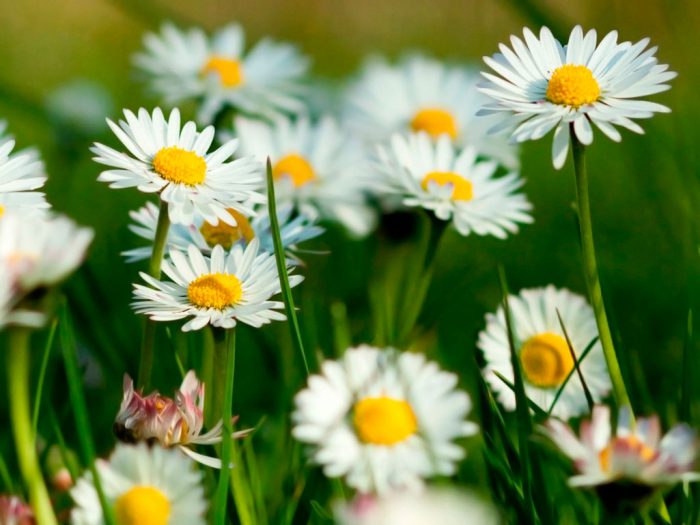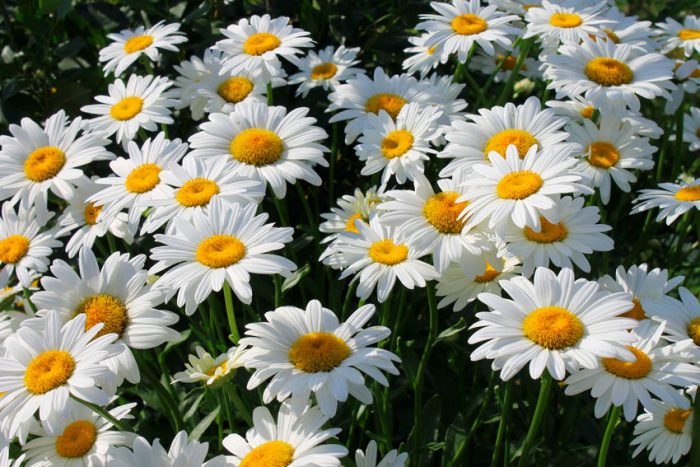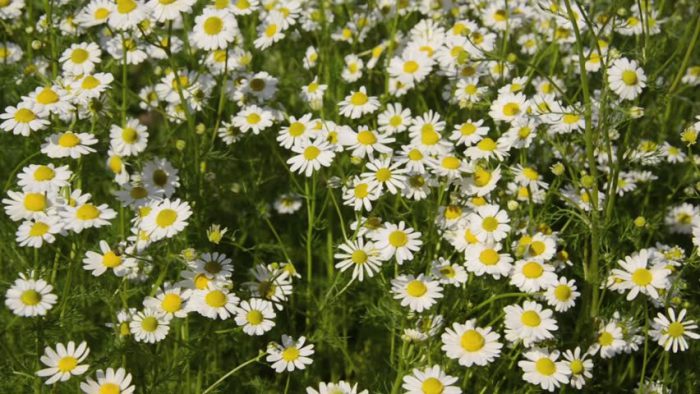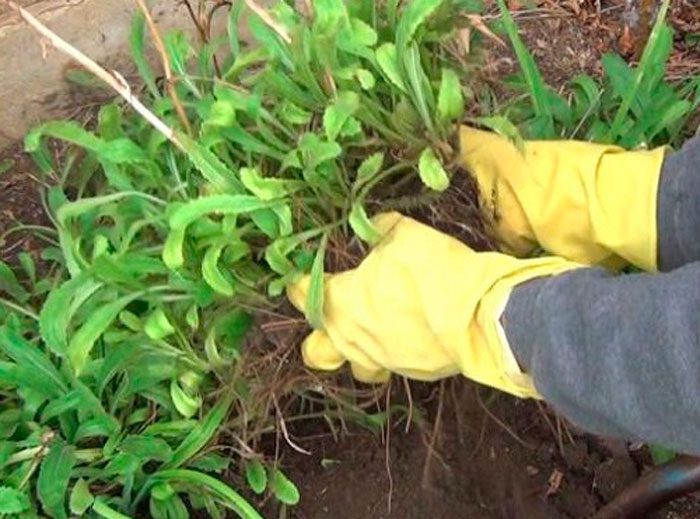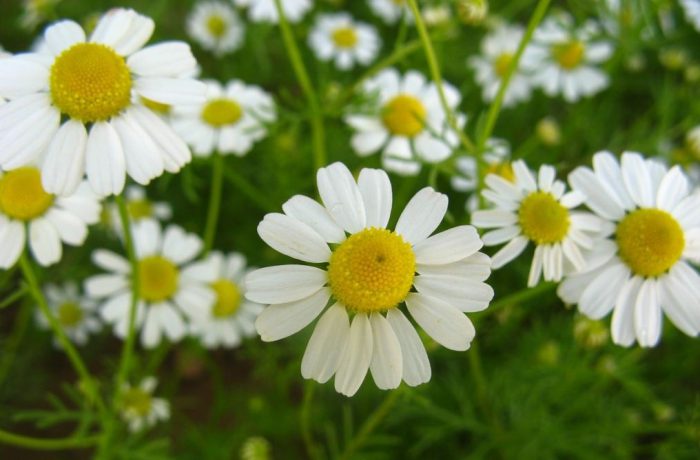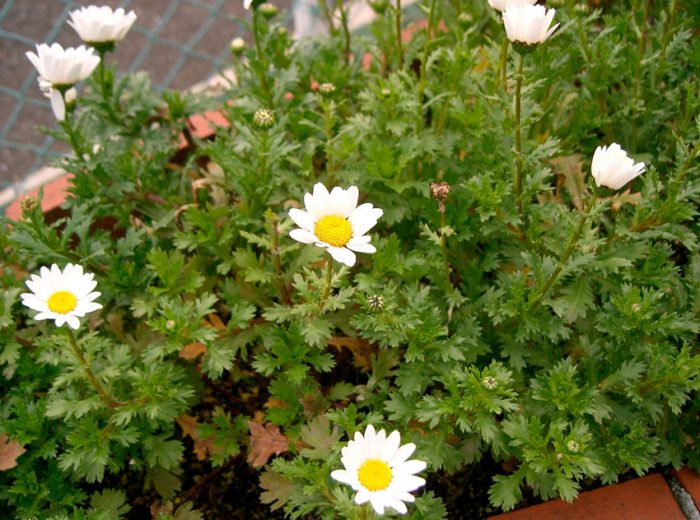Chamomile (Matricaria) belongs to the genus of flowering herbaceous perennial plants, which are members of the Asteraceae or Asteraceae family. This genus unites about 20 species of aromatic herbs that are not very tall, which begin to bloom in the first year of life. In the wild, such flowers can be found in North and South America, Australia, Eurasia and South Africa. It is interesting that such flowers once adorned Central Africa, but the local tribes did everything to destroy them, because they were sure that daisies are able to attract evil spirits.
The most popular of all types is chamomile, which has medicinal properties. It is widely used both in the production of medicines and cosmetics. Chamomile is translated from Latin as "uterus". The fact is that such flowers were very often used in the treatment of gynecological diseases. So, in the multivolume "Natural History" Pliny the Elder describes this flower, calling it Chamaemellon. This name is made up of 2 words, which translate as "low" (because of the size of the flower) and "apple" (the smell was similar to apple). The name used in Russia comes from Poland, and it comes from the word romana - "Roman".
Often, gardeners call garden chamomile gerbera, pyrethrum, cornflower, aster and chrysanthemum. Such plants belong to the Aster family and are not chamomile. This article will focus on the daisy, although it is not a chamomile, but planting and caring for them are very similar. In this case, the daisy, which would be more convenient, will be referred to below as chamomile.
Content
Features of chamomile
Garden chamomile (Leucanthemum vulgare) is also called daisy, as well as popovnik. The height of such a herbaceous plant can reach 15-60 centimeters. The root is quite short, the stem is erect and slightly faceted, the basal leaf plates are crenate, spatulate, located on rather long petioles, while the stem leaf plates are oblong, with denticles unevenly located along the edge.Stem leaves in the amount of two pieces located at the top of the stem are smaller than those located below. The flowers are presented in the form of hemispherical inflorescences-baskets, the diameter of which can reach 2.5-6 centimeters. They are collected in shields. In the middle of the baskets there are tubular bisexual flowers of yellow color, and along the edges there are long pseudo-ligate, as a rule, white (there are also yellow) flowers that are sterile. The fruit is presented in the form of achenes.
There are about 20 species in the genus of the Nivyaniki plant.
Growing chamomile from seeds
Sowing chamomile
These flowers can be grown both through seedlings and in a seedless way. Sowing seeds, if necessary, is carried out directly into open soil, however, the seedling method has established itself as the most reliable. Sowing seeds for seedlings is carried out in early spring, or rather, in March. For sowing, you need a tray with cells. It should be filled with light, moist soil, which is well air-permeable, which includes peat and sand (1: 1). 2 or 3 seeds should be placed in 1 cell, and then sprinkled with a thin layer of soil mixture. A film is placed on top of the container, which must be transparent. Then it is placed near the window opening. At the same time, you cannot put the container on the windowsill, because sunlight can harm the process of sprouting. Spray the soil with a sprayer immediately after it dries slightly.
Chamomile seedlings
At normal room temperature, the first seedlings should appear after 10-14 days. After this happens, the shelter should be removed, and the container should be placed in a well-lit place on the windowsill, and do not forget to protect the plant from a draft. In the event that you cannot find a sunny place for chamomile, it is recommended to place a fluorescent lamp above the container, while the daylight hours should be about 14 hours. After the seedlings grow to 5 centimeters, it will be necessary to thin out the seedlings. To do this, remove weak plants, leaving 1 strongest in 1 cell. However, it is impossible to pull out chamomile during thinning, as this can contribute to injury to the root system of the remaining plant. An unnecessary seedling is recommended to be carefully broken off above the soil surface. To increase branching, it is necessary to pinch the seedling over 3 or 4 leaves.
Planting chamomile in open ground
What time to plant seedlings
The grown seedlings should be transplanted into the soil after 1–1.5 months have passed from the moment of germination. Also, the threat of frost should be avoided on the street. Choosing for planting garden chamomile should be a well-lit area with direct rays of the sun, on which there is a neutral or limestone soil. Groundwater must necessarily lie quite deep.
Disembarkation
Before planting chamomile, you need to prepare the site. To do this, you need to dig it up, adding a complex fertilizer for flowers. The depth of the pits should be from 20 to 30 centimeters, while between the bushes it is necessary to maintain a distance of 20 to 40 centimeters. The distance between the pits, as well as their depth, directly depend on the plant variety. The plant must be carefully pulled out of the cell with a lump of earth and placed in the hole. After that, it is covered with soil, and the surface is slightly tamped. Then watering is carried out. The daisies will begin blooming next year.
Features of caring for garden daisies
How to care for chamomile
After the seedlings are transplanted into open soil, they should be systematically watered frequently. However, after the chamomiles take root and begin to grow, it will be necessary to reduce watering, and carry it out only in dry weather. After watering, it is recommended to sprinkle the soil surface with a layer of mulch (peat), which will help to avoid rapid evaporation of moisture.And such a plant, like everyone else, must be fed, weeded, and also timely loosened the top layer of soil. Also, garden daisies must be prepared for wintering. The plants are fed every year using peat, humus and compost, which must be introduced into the soil. In the middle of the spring period, ammonium nitrate should be poured onto the soil surface in the aisles in a uniform layer (20 grams of substance per 1 square meter). There is no need to water after this. When budding begins, experts advise adding a urea solution under those bushes that have faded leaf plates and shoots. In autumn, dolomite flour or slaked lime must be added to the acidic soil.
Chamomile propagation
Such a plant can be propagated by seeds, as well as by dividing the bush. It is recommended to grow perennial garden chamomiles in the same place for no longer than 5 years. However, it should be borne in mind that just 2–3 years after planting, the bushes thicken, as a result of which their average stems die, and the inflorescences become smaller. As a result, the bushes become less attractive. To prevent this, young and strong shoots must be planted from the plant in time. This procedure is recommended to be carried out in the last September first October days. Moreover, the day must be cloudy and cool. To do this, you need to separate part of the bush and place it in a pre-prepared hole, which must first be watered with settled water. Then it is covered with nutrient-rich soil. The next time you divide the same bush, you will need to take the dividend from the other side. This method is suitable for reproduction of terry, as well as varietal garden daisies. In the event that you want the bushes to be very powerful and the flowers to be large, it is recommended to divide it every year.
You can also use seeds for reproduction. How to grow seedlings is described above. However, it is possible to sow seeds before winter in open soil. In cold soil, they will not freeze, but will undergo natural stratification. In the springtime, chamomile should rise together. You just have to thin out the seedlings.
Pests and diseases
If the rules of care are violated, it is quite possible that the plants may begin to hurt with gray rot, fusarium, powdery mildew, and rust.
Powdery mildew - it can be identified by a whitish bloom that forms on any part of the plant, except for the root system. Over time, it takes on a brown tint.
Rust - specks of auburn color appear on the front side of the leaf plates, while on the seamy side you can find pads with fungal spores.
Fusarium - this fungal disease leads to the fact that rot on the root collar and root system appears in young bushes, while the tissues change their color to brown. The shoots become thinner, and yellowing of the leaf plates occurs.
Gray rot ― On the surface of foliage and stems, brown necrotic specks are formed, which grow quickly enough. If the air humidity is increased, then a grayish mycelium fluff forms on the surface of the spots.
As a prophylaxis against fungal diseases, it is necessary not to allow the soil to be too wet, you need to loosen it in a timely manner, and also carry out regular weeding. If a gray rot appears on the bush, then it should be destroyed as soon as possible, this will help stop the spread of the infection. In case of infection with fungal diseases, treatment with fungicides is recommended, for example: Topaz, Oxyhom, Fundazol, Cuproxat, etc. It is necessary to treat the plants at least 2-3 times, while the duration of breaks should be equal to 1-1.5 weeks.
The garden chamomile is home to thrips, wireworms, aphids, and the star-winged fly.
Star-winged front sight - it is so called because on the surface of the wing it has a small star-shaped speck. At the base of the middle flowers, its larvae accumulate, which harm the plant. For preventive purposes, it is recommended to remove weeds in a timely manner.
Aphids and thrips - these pests suck out the juice from the parts of the chamomile located above the ground. On the surface of the leaf plates, yellowish or discolored spots, stripes or streaks are formed. The tissues that have been damaged die over time, the foliage withers and falls, and the flowers are deformed, losing their spectacular appearance. When infected, the plant must be treated with insectoacaricides, for example: Agravertin, Karbofos or Actellik.
Wireworms - they are the larvae of the click beetle. Such pests live in the soil for about 4 years and at the same time damage the chamomile root system. To destroy them, you need to make special traps. To do this, put a small piece of carrots, potatoes or beets in the prepared hole. A piece of metal or a board should be placed on top of the trap. Open the trap and get rid of the pests that have accumulated in it should be after 2-3 days. Traps should be laid systematically. Often this pest lives in the area where potatoes grow nearby.
Perennial chamomile after flowering
When and how to collect seeds
In the event that you need to collect seeds, then you should wait until several large flowers are completely dry. Then they must be cut and put in a dry place where there is good ventilation in order for them to dry out. After that, seeds are husked from the middle tubular flowers onto a piece of paper. After you wind them, place them in a small paper bag and store them in a shaded, dry place for storage. They remain viable for 2–3 years. But it should be borne in mind that when propagated with the help of seeds of double and varietal chamomiles, they are not able to maintain parental characteristics.
Preparation for wintering
Perennial garden chamomile should be covered for the winter. Before the frosts begin, it is necessary to completely cut off the aerial part of the daisies. After that, they must be sprinkled with sawdust or fallen dry leaves, or they can be covered with non-woven material.
Types and varieties of daisies with photos
In addition to meadow chamomile (common daisy), gardeners grow other species.
Meadow chamomile (Leucanthemum vulgare)
It is also called the common daisy. It is found naturally in Ukraine, in the southern part of Siberia, Western Europe and the European part of Russia. This perennial plant can reach a height of 90 centimeters. The diameter of single inflorescences-baskets is from 6 to 7 centimeters, the tubular flowers are yellow, and the ligulate ones are white. This species has been cultivated since 1500. Most popular varieties:
- Sanssouci - it reaches 100 centimeters in height, and the diameter of the inflorescence is 12 centimeters. The ligulate flowers are arranged in 6-8 rows and have a white color, yellow median ones - there is a small amount.
- May Queen - this chamomile is very popular among amateur gardeners. Half-meter bushes have glossy foliage, rich dark green color, which forms the ground cover.
- Maxima Koenig - on a meter-long bush flowers flaunt, the diameter of which is 12 centimeters. The middle flowers are dark yellow, and the 2 rows of reed flowers are white.
Kuril daisy (Leucanthemum kurilense)
This rocky plant is late flowering. It occurs naturally on the island of Hokkaido and the Kuril Islands. The fleshy rhizome is thickened. The bush is 20 centimeters high and contains a small number of single baskets, the diameter of which is 5–8 centimeters. The color of the marginal flowers is white. The arcticum variety has a different leaf shape.
Marsh daisy (Leucanthemum paludosum)
Also called marsh chrysanthemum (Chrysanthemum paludosum) - found in the south of Spain and Portugal. The height of the branchy bush is no more than 25 centimeters. On it there are alternately located, sessile spatulate leaves of a rich green color, crenate along the edge. The diameter of a large number of inflorescences-baskets is 3 centimeters. White ligulate flowers are short, and there is also a large middle, consisting of yellow tubular flowers.
Leucanthemum maximum
Homeland is the Pyrenees. The bush of a perennial plant has a height of 0.5 to 1 meter. There is a short ground rhizome, sessile spatulate leaf plates with a crenate edge. The diameter of the inflorescences of the baskets is from 10 to 12 centimeters. Simple inflorescences consist of white marginal flowers arranged in 2 rows, as well as yellow tubular median ones. The composition of the terry inflorescences includes many white reed flowers, located in several rows, while the middle tubular ones have a white color. Such inflorescences are similar to chrysanthemum. Cultivated since 1816 Popular varieties:
- Alaska - the diameter of the inflorescences is 10 centimeters, there is 1 row of white reed flowers.
- Beethoven Is an abundantly flowering variety. Simple inflorescences are located on a half-meter bush.
- Stern von Antwerp - meter bushes have inflorescences with a diameter of about 10 centimeters. The tubular flowers are yellow, and the reed flowers are white.
- Schwabengrub - bush up to 80 centimeters, terry inflorescences, pure white.
- Little Princesses - the height of the spectacular bush is 20 centimeters. There are large snow-white inflorescences.
Also, how garden chamomile is grown: feverfew, erigeron, odorless chamomile, matricaria and umbilicals. They all belong to the Aster family.

